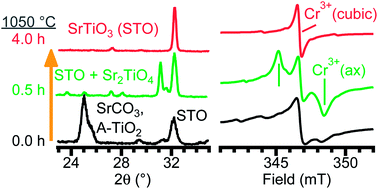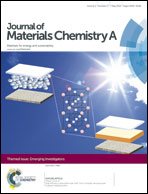Speciation of Cr(iii) in intermediate phases during the sol–gel processing of Cr-doped SrTiO3 powders†
Abstract
The local environment of Cr3+ during the sol–gel synthesis of 1% and 5% Cr3+-doped SrTiO3 (Cr3+:SrTiO3) bulk powders was systematically studied by structural characterization techniques and dopant-specific spectroscopies. After calcination at 800 °C, the precursors were annealed between 850 °C and 1050 °C for up to 6 h. We observe the formation of numerous phases in addition to the final product of SrTiO3. One of these is a metastable Ruddelsden–Popper phase (Sr2TiO4) that forms when the precursor is annealed at 1050 °C for less than 2 h. Electron paramagnetic resonance (EPR) spectroscopy reveals a new signal that correlates with appearance of the Sr2TiO4 phase and is consistent with Cr3+ substitution into the axially-compressed Ti4+ site in Sr2TiO4. The best agreement between experiment and the simulated EPR spectra of Cr3+:Sr2TiO4 is when |D| = 0.0207 cm−1, g∥ = 1.9803 and g⊥ = 1.9793. The majority of the sample is converted to Cr3+:SrTiO3 with increasing annealing times at 1050 °C as detected by low-temperature emission and EPR spectroscopies, and powder X-ray diffraction.

- This article is part of the themed collection: Emerging Investigators

 Please wait while we load your content...
Please wait while we load your content...